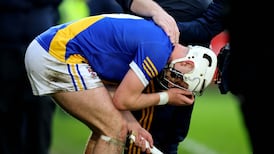Let us offer up some prayers for Nickie Quaid
The angriest Henry Shefflin was at any stage on Saturday evening was in the immediate aftermath of Evan Niland’s free that put Galway 1-12 to 1-6 ahead. Kyle Hayes had chopped down on Brian Concannon’s hand and earned himself a yellow card for his troubles. The game had been completely frenetic – Niland’s point made it 32 shots on goal by the two teams inside 24 minutes. Galway were loving it.
We all know what happened next. Nickie Quaid didn’t even watch the ball go over the bar. As soon as Niland struck the ball, he leaned on his hurley, unclipped his helmet and took a knee. On the sideline, fully 80 metres away, Shefflin went ballistic. He knew – as everyone knew – what was happening. Quaid was being entirely blatant in taking the sting out of the game but there wasn’t a thing Shefflin or anyone could do about it.
Watching it back from the camera angle high behind Quaid’s goal, you can see the Limerick players immediately cop what is happening as well. Some of them gravitate towards the Hogan Stand sideline, others come closer to each other to have a word. John Kiely is immediately out to the edge of his box, leaning out and shouting messages to his forwards. Meanwhile, Shefflin is giving out to the fourth official and the linesman at the brazen carry-on.
The game was stopped for just short of two minutes. When it resumed, Galway’s rhythm was completely halted. The game got a little more bitty. Fewer shots, fewer scores. The period immediately following Quaid’s mini-emergency was the longest stretch of the game without a score for either team. A semi-final that had been bubbling along at just short of a score a minute went a full six minutes without an umpire raising a flag.
READ MORE
It ended with Diarmaid Byrne landing a long range free on the half-hour mark. Limerick outscored Galway the rest of the way by 1-18 to 0-6.
Job done, Nickie. In spectacular fashion. – Malachy Clerkin
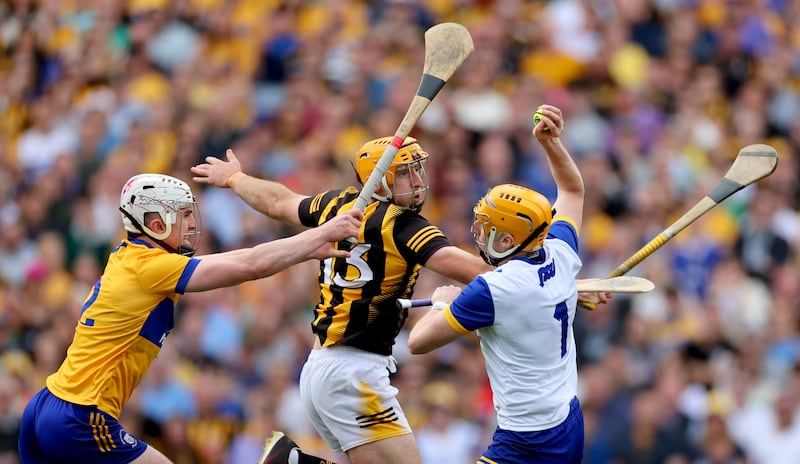
One is the loneliest number
One way or another, goalkeepers entered the conversation over the weekend. Eoin Murphy’s save from Peter Duggan’s overhead smash might have been the best of his illustrious career; Eibhear Quilligan made an astonishing save from TJ Reid and a terrific stop from Eoin Cody and then was fingered at the scene of Eoin Cody’s goal.
Eanna Murphy’s puck-outs on Saturday were good, and then not so good, and they figured prominently in the first draft of the autopsy. Putting the ball in motion against Limerick is the knottiest problem in hurling. It falls to the goalie.
“The standard of goalkeeping now - they’ve got so much pressure with their puck-out and their shot stopping as well. But some of these guys are just outstanding,” said Brian Lohan.
Playing in goal has never been more complex or unforgiving. It is the nature of forward play now, that a shot for a goal is rarely taken unless the shooter is certain he can make an unimpeded swing at close range; a lot of the time they can see the whites of the goalie’s eyes. No chance.
The ball has never travelled as far, and even on a calm day, landing the ball on the other D is within the compass of every goalie, but no team really wants to take that vanilla option. The pressure to find a receiver and made a good decision is enormous. Derek Lyng mentioned the importance of bringing on Walter Walsh, just to give Eoin Murphy some relief with another viable target.
In the first half on Saturday Eanna Murphy landed a puck-out in space, behind Kyle Hayes, and into the path of Cianan Fahy, who gathered the ball in his stride and was fouled for a converted free. It was a remarkable piece of vision and shot execution. In Limerick matches, though, the opposition goalie will have the ball in his hand at least 40 times. How many good decisions do any of us make in a day? – Denis Walsh
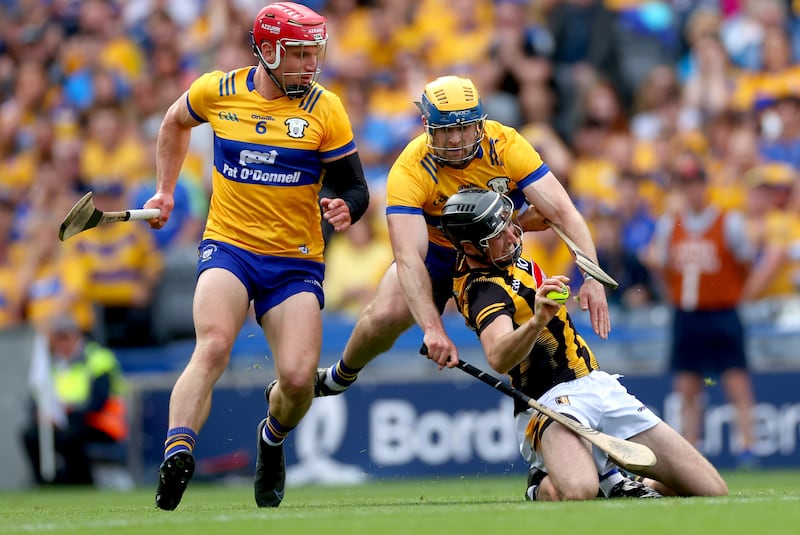
Clare and Galway demonstrate the dangers of overthinking
“We’re just concentrating on ourselves.” It’s one of those routine stock answers regularly thrown out by managers and players. It covers many bases and avoids divulging any analysis of the opposition.
Of course, it would be reckless not to study their opponents – especially in this ever-evolving era for hurling and football – and all sides do it. Indeed, they have dedicated teams within the management set-up which break apart the opposition. But there was a sense from the weekend’s hurling semi-finals that at times it is possible to overthink it.
Galway had Limerick on the run in the first half, the Treaty County even needed to create a Nickie Quaid-inspired breather to break the Connacht side’s momentum. Galway’s success in that first half had been achieved largely by going at Limerick, players running hard, showing huge aggression and desire.
But when Limerick started to gain a foothold, Henry Shefflin changed tack and dropped Cathal Mannion deeper, not quite a plus-one centre back, but certainly in a more defensive role than he had been operating from during the first half. Galway had abandoned playing with abandon, as such. They went with a more cautious plan and Limerick picked them open thereafter.
On Sunday, Brian Lohan started with a sweeper against Kilkenny – a game most pundits would have seen as 50-50 before throw-in. Clare had come through a tougher provincial championship, looked more road-tested and they also had the element of revenge to motivate them from last year. You’d have fancied Clare to tear at Kilkenny from the off, but by deploying a sweeper the mentality was one of caution and control.
The optics of such a tactical decision must surely have emboldened Kilkenny. Clare only lit up when they changed that approach at half-time and actually played on the front foot. Had they shown such positivity from the off then who knows what might have happened. Teams don’t just concentrate on themselves, indeed some spend so much time considering their opponents that it can be easy to overthink matters. – Gordon Manning
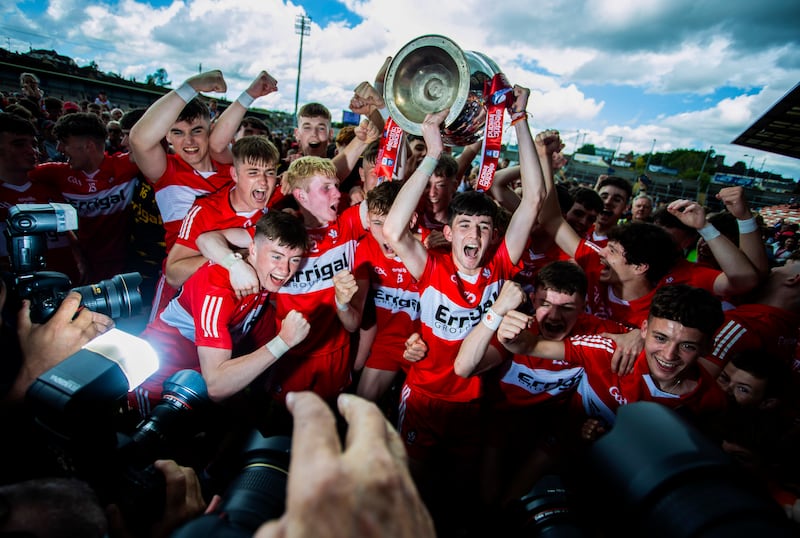
The GAA was right to take the All-Ireland minor final out of Croke Park
The All-Ireland minor football championship was a terrific tournament this year and on Saturday, it got the champions it deserved. Derry were flagged as having a pretty special crop coming through but you can never really be confident of this stuff when you’re talking about teenagers.
Monaghan electrified their county by making a first All-Ireland final at any grade in 84 years. Dublin and Kerry shimmered with some luminous individual talent that we will obviously hear from in the future.
The only slightly discordant note over the weekend came in the form of the two managers in the final – Damien McErlain of Derry and Dermot Malone of Monaghan – complaining that the game should have been in Croke Park.
It took place in the Athletic Grounds in Armagh, where a crowd of just short of the 14,000 capacity made the atmosphere fizz throughout – or at least up until Derry sealed the game with a second-half goal. To be fair to Malone and McErlain, they weren’t making a massive deal out of it, just saying it would be nice for the young lads if the final went back to its traditional venue.
Which is fine, as it goes. But if anything, Saturday’s brilliant occasion made the argument in the other direction. Malone was right to say that most of the young men on show will never get to play senior and therefore will probably never play in Croke Park. But by putting the game on in a perfectly-sized ground, they got to play in an atmosphere that would have been impossible in the vast cavern on Jones’s Road.
Also, these are under-17 footballers. The under-20s never have their final in Croke Park, despite being a grade that is far more indicative of who is in the next wave of intercounty players. Neither do the Sigerson or Fitzgibbon, which have become the real finishing schools in the GAA. The only reason the minor finals would be in Croke Park is because it was always there.
Not that we say it too often, but the GAA have got this one right. – Malachy Clerkin
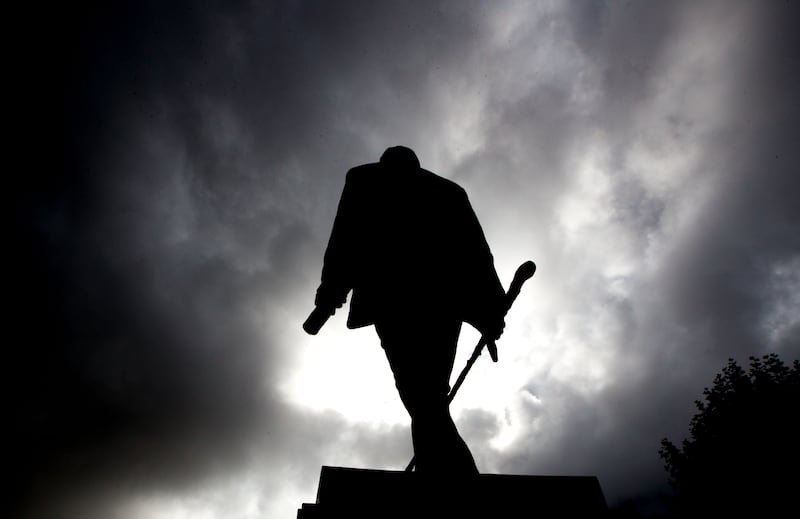
Farewell to Brother MacNamara, a zealous keeper of the flame
The glossy match programmes that are sold these days at big matches in Croke Park mark their own evolution. In days gone by, there was rarely any need for public address announcements about the veracity of the listed teams, which by and large had been announced the previous Tuesday.
For the unwary, there was also the danger of unwittingly picking up an unofficial programme, a scrappy pamphlet with an almost psychedelic impact because whoever printed them never seemed able to get the colour register right.
Modern commercial practice means that it’s probably easier to sell enriched uranium on Jones’s Road than unlicensed product and sales now happen within the stadium.
Page five of Sunday’s programme brought sad tidings that on June 17th, the death had taken place of Brother Seán MacNamara, a native of Kilmurry-Ibrickane, who would have been 96 next October.
He was known amongst other things for being a zealous keeper of the flame for GAA founder Michael Cusack and in 2006 on the centenary of Cusack’s death, he published a biography, The Man from Carron, and lectured widely on the subject.
His research turned up, amongst other things, an original diary. The twin emphases of this work are to reinforce the central importance of Cusack to the both the GAA, which he founded and the cause of Irish nationhood as well as to convert everyone to the view that the GAA’s birthplace was not Hayes’s in Thurles but another hotel, the Dergvale.
A popular institution on match days, the Gardiner Place hotel was in the late 19th century the location of Cusack’s phenomenally successful academy, which prepared candidates for civil service exams.
In 2010 the Dergvale unveiled a memorial to its famous previous occupant and screened a DVD, which was scripted and presented by Brother MacNamara. He pointed out that the letters inviting people to attend the inaugural meeting in Thurles on November 1st, 1884, were sent from Gardiner Place on October 27th.
Cusack is these days memorialised by Paul Ferriter’s imposing sculpture outside the GAA Museum, behind the eponymous stand.
Brother MacNamara was of the view that naming a stand after the founder was understatement and believed that the stadium should have been named after him rather than Archbishop Croke.
On a disappointing day for Clare, the county’s presence in the games’ great cathedral lives on – abetted by another of its distinguished sons now gone to his eternal rest. – Seán Moran







